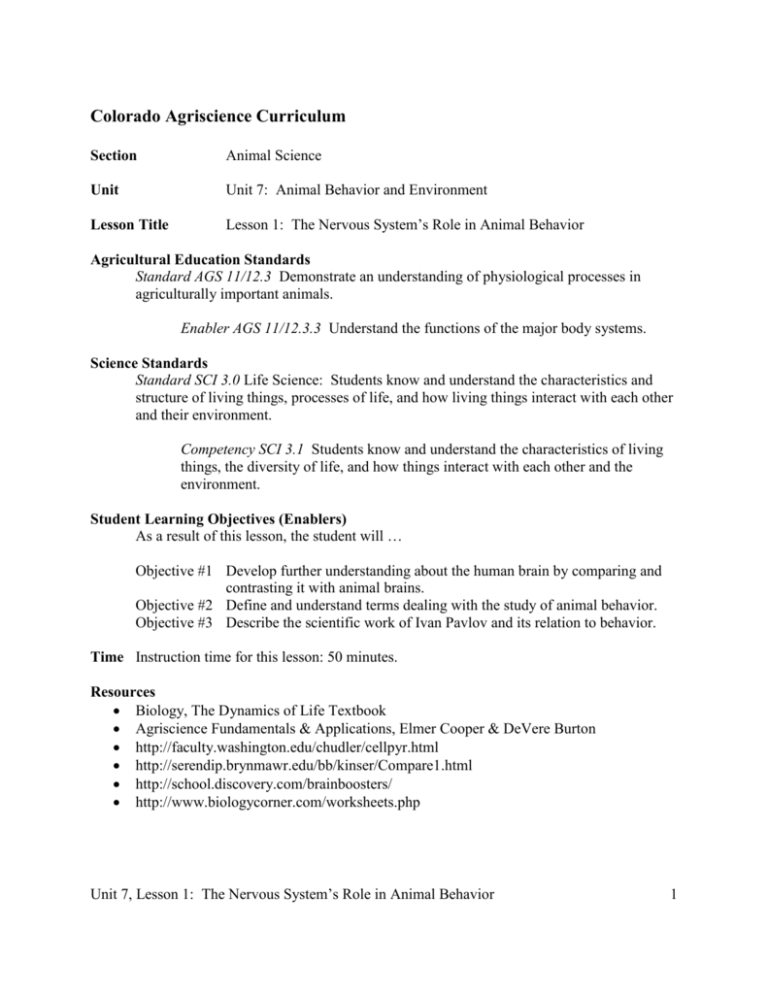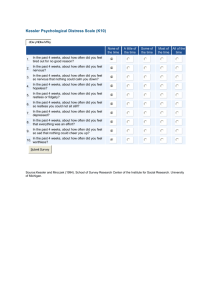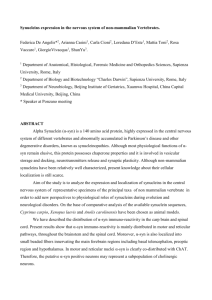Lesson - Animal Science
advertisement

Colorado Agriscience Curriculum Section Animal Science Unit Unit 7: Animal Behavior and Environment Lesson Title Lesson 1: The Nervous System’s Role in Animal Behavior Agricultural Education Standards Standard AGS 11/12.3 Demonstrate an understanding of physiological processes in agriculturally important animals. Enabler AGS 11/12.3.3 Understand the functions of the major body systems. Science Standards Standard SCI 3.0 Life Science: Students know and understand the characteristics and structure of living things, processes of life, and how living things interact with each other and their environment. Competency SCI 3.1 Students know and understand the characteristics of living things, the diversity of life, and how things interact with each other and the environment. Student Learning Objectives (Enablers) As a result of this lesson, the student will … Objective #1 Develop further understanding about the human brain by comparing and contrasting it with animal brains. Objective #2 Define and understand terms dealing with the study of animal behavior. Objective #3 Describe the scientific work of Ivan Pavlov and its relation to behavior. Time Instruction time for this lesson: 50 minutes. Resources Biology, The Dynamics of Life Textbook Agriscience Fundamentals & Applications, Elmer Cooper & DeVere Burton http://faculty.washington.edu/chudler/cellpyr.html http://serendip.brynmawr.edu/bb/kinser/Compare1.html http://school.discovery.com/brainboosters/ http://www.biologycorner.com/worksheets.php Unit 7, Lesson 1: The Nervous System’s Role in Animal Behavior 1 Scientific Farm Animal Production, Taylor, Fourth Edition Tools, Equipment, and Supplies PowerPoint Presentation Inflated balloon/pin Music Internet connection Worksheet for Students Copies of mazes (3 per pair of students) Stopwatches Key Terms. The following terms are presented in this lesson and appear in bold italics: Intelligence, Reasoning, Habituation, Conditioning, Instinct, Ethology, Cerebral cortex Interest Approach Pick out one or several students in the class who has a pet and ask them the following questions to begin a discussion about the intelligence of animals. How smart is your dog? How do you know he’s that smart / dumb? What type of actions make you think that he can think and understand at some level? After some discussion, share the following information with the class. Rena Durr, a psychology professor at Christian Brothers University in Memphis, subscribes to the notion that animal intelligence is essentially a problem-solving issue. Instinctual behaviors never change, whether or not they are appropriate. "If animals relied solely on instinct, we would not see the individual variations in behavior within species -- for example, the observation that some cats rescue their babies from burning buildings, while others kill and eat their babies," Durr said. She noted that octopuses were added to the list of animals that require ethical treatment in labs after one was seen reaching out of his tank and pulling a string to turn off a light bulb above. He preferred the dark, like the bottom of the ocean." For years, people have been speculating and hypothesizing about the levels of intelligence that animals have. Today, we’re going to take the knowledge that we gained from Unit 3, Lesson 7, The Nervous System, and apply it to the animal’s world to compare and contrast animal and human nervous systems. The things we learn will lead us into our study of animal behavior. Summary of Content and Teaching Strategies Objective 1. Develop further understanding about the human brain by comparing and contrasting it with animal brains. Use the Animal Nervous Systems Powerpoint presentation and attached worksheet to review part 1 of the lesson and compare and contrast. Unit 7, Lesson 1: The Nervous System’s Role in Animal Behavior 2 On the worksheet I’ve given you today, I’d like you to take five minutes and write 5-7 sentences answering the question at the top of your page. Can animals think? There is no right or wrong answer right now, but I want you to support your opinion with some examples from your life. There’s no need to talk right now, and I’ll turn on some music for you to enjoy while you write. Don’t worry if you see me looking over your shoulder – I’m just curious about your opinion. OK, impress me with your opinion! (Turn music on and walk around room to get an idea of where the students stand on this topic. Afterwards, ask a few students to share their answers.) Using the worksheet as a guide for note taking, go though slides 1-8 with students. Objective 2. Define and understand terms dealing with the study of animal behavior. Use slide number 9 to introduce ethology, or the study of animal behavior. Then students will alternate taking notes on the slide and completing a short activity for slides 10-13. Slide 10 – Read definition and take notes. There are two ways to illustrate reflexes. The Startle Reflex is best illustrated when I do this . . . (pop a balloon with a pin.) Most of you jumped. Why? To illustrate the second way, you need to get up and press your arm against a wall for 1 minute, then step away and relax. After doing this, the arm should raise. Why does this happen? Do you have to consciously think about it for it to happen? Slide 11 – Read definition and take notes. In the margin of your paper, write this sentence: Agriculture is an important part of society. Now, take a look at your sentence. Did you all dot your i’s and cross your t’s? How did you know to do that even though I didn’t tell you too? It’s a habit you formed years ago in elementary school when you learned to write. An important part of habituation is trial and error. When I say go, find yourself a partner quickly and I’ll bring you a maze for one person to complete while the other times him or her. (After completed, hand out another copy of the same maze and give them the same instructions. After the third time, compare the times and you should see a decrease with trial and error.) Slide 12 – Read definition and take notes. Try your reasoning skills on these: Although each of the following sentences sounds okay at first, there's really something wrong with each one of them. Read the sentences and explain why each one is a little "fishy." 1. No one goes to that restaurant any more because it's too crowded. 2. I'm glad I don't like spinach, because if I liked it, I'd eat it, and it tastes awful. 3. If you can't read this sign, ask for help. Answers: Unit 7, Lesson 1: The Nervous System’s Role in Animal Behavior 3 1. 2. 3. If no one goes to the restaurant, it can't be crowded. If the person did like spinach, he or she wouldn't think it tasted awful. If the person can't read the sign, she or he won't know that it says to ask for help. Here’s another: A man named George was hurrying to get ready for a dinner party when Dan rang his doorbell. "I'm just rushing off to a dinner party," said George, "but I'm sure it would be fine if you came along." So the two went off together. When they arrived at the party, George, who always enjoyed getting people to use their heads, introduced Dan to the other guests with the following rhyme: "Brothers and sisters have I none, but this man's father is my father's son." How were George and Dan related? (Dan was George’s son) These seem easy to you – but only because you know how to use your reasoning skills. Slide 13 – Read definition and take notes. Intelligence is often judged by using exercises to test short and long term memory or test your ability to recognize patterns. Try this one. What do the three words in each of the following groups have in common? (Example: What do the words "ram," "raven", and "bull" have in common? All three animals have given their names to sports teams.) 1. saddle, pump, slide 2. mustang, cougar, rabbit 3. department, shoe, book Answers: 1. Each word names a different kind of shoe. 2. Each word names an animal that has given its name to a kind of car. 3. Each word names a different kind of store. Make sure each of the terms we discussed today is captured on your worksheet because we’ll use them tomorrow to learn about the basic 10 types of animal behavior. Objective 3. Describe the scientific work of Ivan Pavlov and its relation to behavior. Use slides 14-16 to teach students about the work of Ivan Pavlov and conditioning. The first two slides are informative. At the end of the second slide, follow the link to play a simple game on the internet that illustrates this concept. Then use the third slide to review. At the end of the three slides, ask students to use pictures instead of words to illustrate the concept on their worksheet. Review/Summary. The last item on your worksheet asks you to re-evaluate your stance on the question “Can animals think?” The difference is this time; you must describe your opinion without using full sentences. Instead, you’ll use an outline format. I challenge you to include some of the terms we just learned. Unit 7, Lesson 1: The Nervous System’s Role in Animal Behavior 4 The last thing we need to review today is some of the vocabulary words we introduced. The better you learn them, the easier tomorrow’s work will be. You have about 5 minutes to spend with a partner, quizzing each other over the words on your worksheet. Go! (Turn on the music if you want.) Application Extended classroom activity: The last slide of the PowerPoint presentation contains pictures of a bos indicus brain and zebra brain. Compare and contrast them with students while reviewing what was learned in Unit 3, Lesson 7: The Nervous System about the parts of the brain and their functions. This activity could include an outcome of writing / drawing / speaking / debating. FFA activity: The topic of animal behavior is a controversial one that would be perfect for debates. Students can meet one degree qualification by leading a 10 minutes discussion with the class. This is also a good topic for prepared public speaking. SAE activity: Students could complete an exploration SAE project by researching careers that deal with animal behavior (ranching, horse trainer, vet, etc.) Evaluation. Students should evaluate what they have mastered with the attached multiple choice quiz as well as a grade for their worksheet, complete with drawings, writings, etc. Answers to Assessment: 1. 2. 3. 4. 5. 6. 7. 8. B A C B A C B A Unit 7, Lesson 1: The Nervous System’s Role in Animal Behavior 5 The Nervous System’s Role in Animal Behavior Name ______________________________________________ Date ______________ Can animals think? In 5-7 full sentences, describe your opinion with examples. Vertebrates have many similarities . . . •_____________________________, consisting of brain and spinal cord. •_____________________________, consisting of nerves that carry information to and from the rest of the body to the central nervous system. There are some differences . . . •The overall _______________. •_________________________ differences •In some brains the ___________________________ is particularly smooth and in some others there is lots of cortical folding What do these differences mean? So, can animals think? Unit 7, Lesson 1: The Nervous System’s Role in Animal Behavior 6 What are some of the views? Define the following words: Ethology: Instinct: Habituation: Conditioning: Reasoning: Intelligence: Pavlov’s Dogs Use pictures (no words) to illustrate the experiments that Pavlov did to learn about conditioning Unit 7, Lesson 1: The Nervous System’s Role in Animal Behavior 7 and animal behavior. Can animals think? Has your opinion changed. In outline form describe your opinion, with examples. Do not write any full sentences! Unit 7, Lesson 1: The Nervous System’s Role in Animal Behavior 8 Mazes for objective #2 Unit 7, Lesson 1: The Nervous System’s Role in Animal Behavior 9 Animal Nervous Systems and Behavior Quiz Name _____________________________________ Date ___________________ 1. Vertebrates species all have different A. Central Nervous Systems B. Brain Sizes C. Peripheral Nervous Systems 2. In a human brain, which area is dedicated to thinking, covers up and dominates anything else? A. Cerebrum B. Brain Stem C. Cerebellum 3. The scientific study of an animal’s behavior in response to its environment is A. Sociology B. Behaviorology C. Ethology 4. Instinct is A. A disease contracted from fecal matter B. Reflexes and responses that animals have at birth C. The ability to act without thinking. 5. Learning to respond without thinking is called A. Habituation B. Stupid C. Reinforcement 6. Reasoning is A. The ability to think quickly B. The use of intelligence C. The ability to respond correctly to a stimulus 7. Intelligence does not include which of the following? A. Short term memory B. Brain size C. Long term memory 8. Pavlov’s dogs drooled when he rang the bell because A. They were conditioned to salivate in anticipation of food. B. They weren’t really very smart. C. They were acting by instinct. Unit 7, Lesson 1: The Nervous System’s Role in Animal Behavior 10






